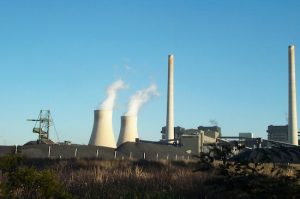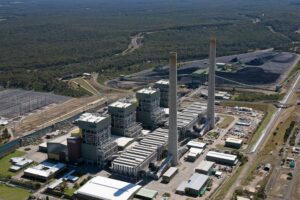
The blackout that occurred in South Australia as well as the power price rises in that state since the closure of their two coal fired power stations have been hailed by a range of media commentators and senior politicians as the horrors that come from too much renewable energy. As a warning that we must resist further attempts to reduce carbon pollution in order to avoid dangerous global warming. This is the case even though the root causes of the power price rises lie with increases in the cost of gas and the blackout with lightning strikes and wind damage to transmission lines.
No doubt these fearful calls will grow even louder now that Engie has finally provided confirmation it will close Victoria’s Hazelwood Power Station.
Yet those making these calls seem unable to appreciate that the world is changing around them and leaving them behind. They appear to be trapped in some kind of historical town theme park like Sovereign Hill, unable to accept the need to adapt to changing global economic structures, technological advances, new scientific knowledge about human’s influence on the climate, and the fact that some things simply wear out over time.
While many of these voices of fear are powerful here in Australia, they are but irrelevant minnows in a world of global trade and finance. Their opinions count for zero to many leaders of global corporations when weighted against the fact that the Academies of Science and meteorology bureaus of all the major economies in the world, without a single exception, agree that humans are causing significant global warming.
It is important to understand that the decision to close Hazelwood came from a global directive out of the Paris head-office of global energy company Engie. The writing was clearly on the wall back in May this year that the plant would close. At that time Engie’s CEO, Isabelle Kocher told a French Senate committee that they were intending to close Hazelwood Power Station. This was reported by the Australian press, but for some bizarre reason the press took the denials of such a decision from Engie’s Australian branch office seriously. Interestingly Victoria’s Energy Minister also told parliament that Engie had no plans to close Hazelwood.
If they’d checked Engie’s global website they’d have found an interview Kocher gave to France’s major newspaper – Le Monde that illustrated the branch office should have been ignored.
In the interview Kocher states;
“Climate change is changing everything….The 21st century will mark the end of fossil fuels, which will gradually be replaced by energy from decarbonized renewable resources, such as solar power”.
Now normally I’d take such a vague general statement with no specific significant corporate actions, dollars and timing attached with a big fat grain of salt. But she then tells Le Monde the company has a three year, €15 billion program to divestment program to withdraw from their oil and gas assets, in combination with a €15 billion investment program focussed on renewables and new energy technologies. She also acknowledges that there’s some bad news involved in that it will come with significant job losses and that €100 million per year had been allocated to support staff with retraining and other measures to take up new jobs.
About a month or two later information began leaking out that Engie had appointed merchant bankers to sell their Australian gas resource development interests. It then came to light that Engie had engaged Morgan Stanley to sell all their fossil fuel assets in the United States. Kocher’s words were converting into concrete action.
Then in July a trader for a small retailer told me of how Engie, who had previously been the major supplier of Victorian electricity hedge contracts, had completely withdrawn from offering such contracts for 2018 and beyond just a few months earlier.
This was the sealer that Kocher’s statements to the French Senate and Le Monde about her plans to close Hazelwood and get out of fossil fuels were deadly serious.
What’s interesting about this is that Engie could have potentially sold Hazelwood Power Station rather than closing it, after all the power plant’s operating costs are some of the lowest in the National Electricity Market. This is the plan for their younger Loy Yang B, but a suitable buyer for the more than 50 year old Hazelwood plant could not be found.
Interestingly the same thing occurred in relation to Alcoa’s 50 year old Anglesea brown coal power station in 2015.
Both power stations are widely understood to be profitable, generating revenue well above their operating costs.
Yet even though Tony Abbott managed to unwind the carbon price and the Liberal-National Government continue to refuse to acknowledge the need for additional emission reduction policies – both Alcoa and Engie didn’t want these high emitting power stations, and no one else wanted to buy them.
In spite of what Australian politicians might like to pretend, they don’t have super powers that enable them to hold back time and developments occurring internationally. Instead we need to accept and anticipate change.
Unfortunately a number of powerful media commentators don’t help our politicians to be honest with the electorate about the inevitability of change and preparing communities to better respond.
In the wake of the power blackout in South Australia, the Herald-Sun’s Andrew Bolt gloated of how three years ago he had advised the South Australian Liberal leader – Steven Marshall – to campaign against the use of renewable energy in the state. This included the idea of preparing a YouTube video involving Marshall blowing up a wind turbine. With South Australians having suffered greatly from a major power blackout it was surely a vote winner, Bolt surmised. Alas, he lamented, such a video was never created and instead another YouTube clip was available where, “the Playford coal-fired power station in Port Augusta — put out of business by Labor’s green policies — had its towers brought down by explosives.”
According to Bolt this meant, “The world sure got that message: South Australia is closed for investment in heavy industry, and so, soon, will be the rest of Australia if we don’t learn from its madness. Blowing up the Playford station was Labor saying yes to wind farms and the country’s highest power prices, and saying yes to the country’s highest unemployment, too.”
For those who have a small appreciation of the characteristics of Australia’s power sector this is likely to evoke the odd chuckle. Playford Power Station was more than 50 years when it was decommissioned and well past its original planned retirement date. Even before the wind turbines began proliferating in SA after 2003, the old clunker was considered an economic basket-case. As an illustration between 2001 and 2003 the plant was intermittently offline, generating no electricity for 898 days over those three years – more than 80 per cent of the time.
It’s interesting to note that since 2013 when it was clear Tony Abbott would be elected and the supposedly economy-wrecking carbon price was effectively dead, we’ve seen a rash of closures of emissions intensive facilities. This includes other coal power stations – Energy Brix, Playford B, Northern and Redbank. It also extends to industrial production plants including Alcoa’s Geelong Aluminium Smelter, the Kurnell, Bulwer Island and Clyde oil refineries, and the Gove alumina refinery. Unfortunately this list will probably shortly extend to also include the Portland Aluminium Smelter.
We’ve also seen a range of coal mines shut or curtail production and the Whyalla’s steel mill has fallen into financial distress. There’s also no sign of Bluescope restarting the steel blast furnace they closed back in 2011 which the Liberal-National party blamed on the carbon price. In addition, all three of Australia’s car manufacturers announced they’d be shutting down since the carbon price was pronounced dead (although it was always a myth that car making competitiveness was significantly influenced by energy costs).
These closures are occurring in a global backdrop where China is undergoing massive structural adjustment leaving it with a huge overhang of surplus industrial production capacity. Meanwhile rapid technological advancement and growth is occurring in renewable energy and digital technologies.
Andrew Bolt and his collaborators might like to suggest that this could all be unwound if we rolled back Australia’s renewable energy policies. But this is going to mean more workers are left ill-prepared to manage changes that Australia simply cannot avoid.
Tristan Edis is Director – Analysis & Advisory with Green Energy Markets. Green Energy Markets assists clients make informed investment, trading and policy decisions in the areas of clean energy and carbon abatement.









